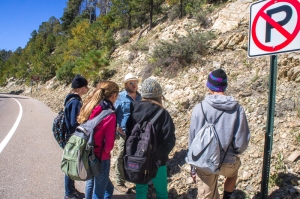In promoting his new book, author Simon Singh put together a short “quiz” of math jokes for The Guardian. I was initially tickled to see an ecological type problem in the very first question:
“1.Why did 5 eat 6?
- Because 1, 2, 3
- Because 7, 8, 9
- Because 5 predates 6″
There is a well-known joke that goes more like, “Why was 6 afraid of 7?” The answer to that is quite obviously, “Because 7, 8, 9!” Such predator avoidance behaviors as 6 being afraid of 7 and perhaps fleeing from it are ubiquitous in animals, as anyone knows who sees sparrows flutter away at your approach in the parking lot. There is a growing body of mathematical theory demonstrating the effect that these avoidance behaviors can have on the actual population dynamics of the prey species, led by scientists such as Peter Abrams and John Orrock. These results are readily demonstrated in experiments: Oswald Schmitz and his colleagues have demonstrated how grasshoppers reduce their feeding and thus slow their population growth rates by avoiding nutritious leaves where spiders may lurk – and the reduced grasshopper population growth rate occurs even when they glue spider mouth parts shut! The effect of fear on the prey species can even transform entire biological communities and their ecosystems.
Well, 7 eating 9 is a great reason for 6 to be afraid of 7, especially if 6 looks anything like 9 (and it sure does to me). But that’s not a good reason for 5 to eat 6. What on earth do we learn about 5 from this other interaction? (Well, it’s prime, like 7, I suppose, so maybe they have similar predaceous traits.) Predators that are coexisting in a community (of integers less than 10?) are quite likely to partition prey in some way as a trade-off that prevents one from excluding another.
But, as Abrams and other theoretical and empirical studies point out, adopting behavior to avoid one predator may make a prey item easier to capture by a predator hunting by a different mode. So if 6 is afraid of 7, it may crowd closer to 5, who, predating it in an ordered number line, can also then prey (or predate) the 6.
Imagine my indignation, then, when I clicked on the end of the quiz to see my answers, only to discover this subtlety completely overlooked by Singh. He had set the answer to this unusually phrased variant of the classic to the well known answer, which frankly, in this scenario, made far less sense.
So since 5 does predate 6, that is a far better reason for 5 to then eat 6, than because some other number like 7 ate the far off 9. I rest my case, sir!





